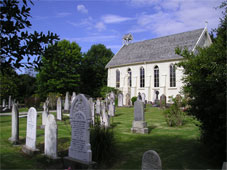
History
A lot of
Russell's early history since 1809 is sketched in the
beach
walk guide as well as in the Te Maiki (Flagstaff) hill walk
guide.
Russell's
original Maori name, Kororareka, means
'sweet little
penguin'. A dying chief reportedly
asked for soup made from the little Blue Penguin.
"Ka reka te korora", he
said ('how sweet is the
penguin'). Pronounce Kororareka
"core-roar-rah-wreck-ah" with rolled
r's, so the "roar" sounds like
"door".
Before 1879 the Russell wharf handled coastal steamers
and larger craft. Still today most visitors arrive by
either the Opua vehicular or Paihia passenger ferries.
What is now Cass Street in the centre of town is wide
leading off the wharf and was originally planned as
'Sydney Square' by
early settlers. The 'Russell
2000' group recently redesigned and
paved it.
Russell (Marine) Radio, now located beneath the Swordfish
Club, is a voluntary organisation and local institution
serving local and offshore vessels since 1951,
contributing to the safety and comfort of seagoing craft
in the huge area stretching from Auckland to the Pacific
Islands. Opua is the first customs port of entry for
visiting yachts from the Pacific or northern Australia.
Russell Museum opened in 1956 and tells the story of the
development of the town from a small Maori fishing
village. Among its collections is a one-fifth scale model
of Captain Cook's
'Endeavour', and
Maori taonga including a small waka (canoe). There are
whaling harpoons and deep sea fishing rods, cannon balls
from the Battle of Kororareka 1845 and tourist china
- and always a fresh, new exhibition.
Christ Church, the oldest existing church in New Zealand,
has its own extensive history dating from its first service
in January 1836 and welcomes visitors to its grounds and
services.
More history can be seen at
'Pompallier', the
sole surviving building of the French Catholic mission
headquarters to the Western Pacific, uniquely French
Provincial in style and housing tanning equipment and a
printing press from the 1840's. It is New Zealand's
oldest Catholic building, and oldest industrial building.
The narrow site was crowded then with a chapel,
cookhouse, well house, workshop, houses for Maori
visitors and boatmen, and other outhouses. Today it is
owned by the NZ Historic Places Trust serving as a
working factory where you can learn about tanning and
printing in those days, as well as the stories of the
people who worked and lived through the fascinating times
of Treaty-making and subsequent war.
Also at the south end of Russell Bay is Motu Kaiaraara,
or Mill Island. In 1858 a windmill was built nearby to
grind locally grown wheat, but a few years later it lost
its sails in a storm.
At the north end of the Bay two fine old and
well-restored homes, Cavalli House and Russell House,
were built for managers of the Masefield
Brothers' fish factory enterprise
which ran for seventeen years from 1889, canning and
smoking mullet. The fish factory has long since gone.
|